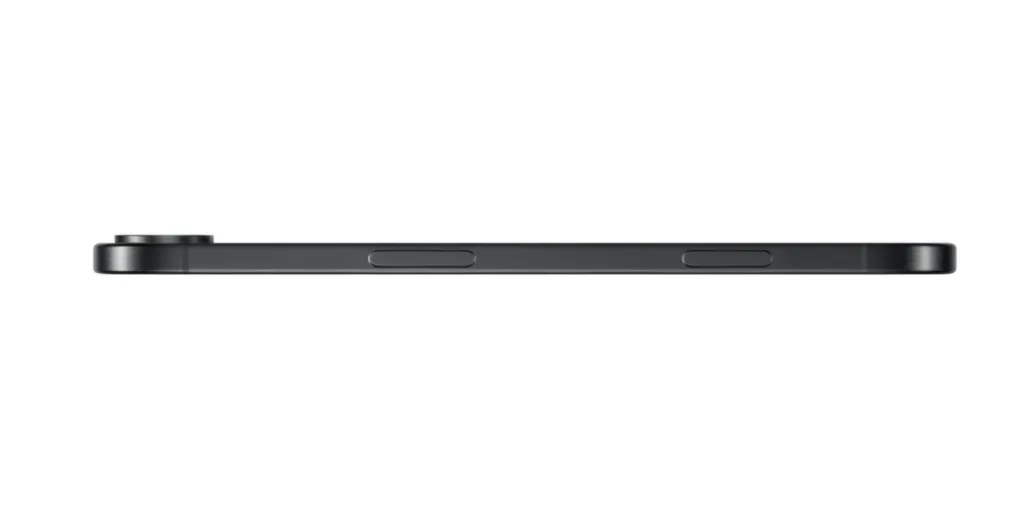Apple is gearing up to launch the iPhone 17 Air, the slimmest iPhone ever, and it’s set to redefine smartphone design. At just 5.5mm thin, it’s pushing the boundaries of sleekness, but there’s a compromise—the camera bump will extend to 9.5mm, making it almost as thick as current models at its highest point. Despite this, Apple’s latest innovation could be a game-changer, replacing the Plus series with an ultra-thin alternative.
Table of Contents
A New Direction: Why Apple is Replacing the ‘Plus’ Model with ‘Air’
For years, Apple has followed a consistent lineup of standard, Pro, and Plus/Max models, but the iPhone 17 Air signals a shift. The Plus variant, which struggled in sales compared to its counterparts, is reportedly being discontinued in favor of a thinner, more premium-looking device that sits between the iPhone 17 and iPhone 17 Pro. Apple seems to be targeting users who crave lightweight yet powerful smartphones without the bulk of a Pro Max.
With the same 6.7-inch display size as the iPhone 16 Plus, the Air is expected to offer a similar screen experience but in a much slimmer body, making it a top choice for those prioritizing portability.
Ultra-Thin Design: The Pros and Cons
The iPhone 17 Air’s ultra-thin form factor is expected to be one of its biggest selling points. However, this extreme thinness brings both advantages and challenges:
✅ Pros:
- Unparalleled sleekness: At 5.5mm thin, it’s among the slimmest smartphones ever made.
- Lighter weight: Easier to carry and hold for extended use.
- Premium aesthetics: A futuristic design that could redefine smartphone trends.
❌ Cons:
- Larger camera bump: The 4mm camera bump makes the thickest point 9.5mm.
- Smaller battery? A thinner frame could mean a smaller battery capacity unless Apple finds a way to optimize power consumption.
- Potential durability concerns: Ultra-thin devices tend to be more fragile.
Camera Innovations: What to Expect from the iPhone 17 Air
Despite its thin body, Apple is not compromising on camera quality. The iPhone 17 Air is expected to feature a single-lens rear camera, housed in a camera bar stretching across the back. This design choice is unique, marking a departure from the traditional square camera module found on recent iPhones.
📸 Key Camera Features:
- Single-lens main camera (possibly using Fusion Camera tech from iPhone 16e).
- Larger sensor for improved low-light performance.
- Advanced AI-powered image processing.
- Ultra-high-resolution photography and cinematic video recording.
This minimalist camera approach suggests Apple is focusing on software optimizations to enhance image quality, much like Google’s Pixel devices.
Performance, Chipset, and Battery Life
A thinner iPhone raises concerns about battery life and performance. However, Apple’s A19 chip (expected in the iPhone 17 lineup) is likely to be more power-efficient than previous generations.
🚀 Performance Expectations:
- Powered by the A19 Bionic chip.
- Improved GPU performance for gaming and media.
- Apple’s custom C1 modem, competing directly with Qualcomm’s Snapdragon X chips.
- USB-C charging, moving away from the Lightning port entirely.
With a more power-efficient processor, Apple might be able to maintain solid battery life despite the ultra-thin design.
Software & Features: iOS 19 and Beyond
The iPhone 17 Air will ship with iOS 19, introducing AI-powered enhancements, better security features, and improved Siri intelligence. Some rumored features include:
- AI-powered text generation and smart replies.
- Smarter Siri interactions with ChatGPT-like capabilities.
- More customization options for the lock screen and widgets.
- Enhanced focus modes and productivity tools.
How the iPhone 17 Air Compares to Previous Models
📊 iPhone 17 Air vs. iPhone 16 Plus
| Feature | iPhone 17 Air | iPhone 16 Plus |
|---|---|---|
| Thickness | 5.5mm (9.5mm with camera bump) | 7.8mm |
| Camera | Single-lens | Dual-lens |
| Processor | A19 Bionic | A18 Bionic |
| Modem | Apple C1 | Qualcomm |
| Display Size | 6.7 inches | 6.7 inches |
| Battery Life | TBD | Larger capacity |
While the iPhone 17 Air is thinner and more advanced in some areas, the iPhone 16 Plus might have an edge in battery life and camera versatility.
Market Reactions and What to Expect
Apple’s decision to replace the Plus model with an Air variant has sparked mixed reactions. Tech enthusiasts are excited about a return to ultra-thin phones, while power users worry about compromises in battery life and camera features.
Pricing & Availability
The iPhone 17 Air is expected to launch in September 2025 alongside the rest of the iPhone 17 lineup. Pricing is still speculative, but it could start at $899–$999.
Final Thoughts: Is the iPhone 17 Air Worth It?
The iPhone 17 Air is shaping up to be one of Apple’s most innovative yet polarizing devices. With its ultra-thin design, single-lens camera, and powerful internals, it will appeal to those who prioritize portability and aesthetics over raw power and battery life.
Would you buy the iPhone 17 Air despite the larger camera bump? Share your thoughts in the comments!
